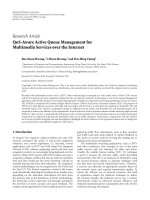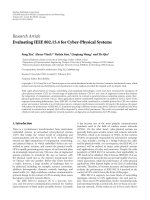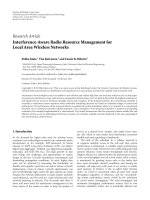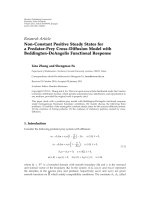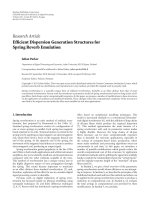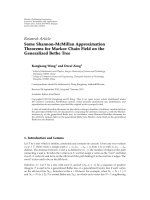Báo cáo hóa học: " Research Article Composite Implicit General Iterative Process for a Nonexpansive Semigroup in Hilbert Space" ppt
Bạn đang xem bản rút gọn của tài liệu. Xem và tải ngay bản đầy đủ của tài liệu tại đây (507.33 KB, 13 trang )
Hindawi Publishing Corporation
Fixed Point Theory and Applications
Volume 2008, Article ID 484050, 13 pages
doi:10.1155/2008/484050
Research Article
Composite Implicit General Iterative Process for
a Nonexpansive Semigroup in Hilbert Space
Lihua Li,
1
Suhong Li,
1
and Yongfu Su
2
1
Department of Mathematic and Physics, Hebei Normal University of Science and Technology
Qinhuangdao, Hebei 066004, China
2
Department of Mathematics, Tianjin Polytechnic University, Tianjin 300160, China
Correspondence should be addressed to Lihua Li,
Received 19 March 2008; Accepted 14 August 2008
Recommended by H
´
el
`
ene Frankowska
Let C be nonempty closed convex subset of real Hilbert space H. Consider C a nonexpansive
semigroup
I {Ts : s ≥ 0} with a common fixed point, a contraction f with coefficient 0 <α<1,
and a strongly positive linear bounded operator A with coefficient
γ>0. Let 0 <γ<γ/α.
It is proved that the sequence {x
n
} generated iteratively by x
n
I − α
n
A1/t
n
t
n
0
Tsy
n
ds
α
n
γfx
n
,y
n
I − β
n
Ax
n
β
n
γfx
n
converges strongly to a common fixed point x
∗
∈ FI
which solves the variational inequality γf − Ax
∗
,z− x
∗
≤0forallz ∈ FI.
Copyright q 2008 Lihua Li et al. This is an open access article distributed under the Creative
Commons Attribution License, which permits unrestricted use, distribution, and reproduction in
any medium, provided the original work is properly cited.
1. Introduction and preliminaries
Let C be a closed convex subset of a Hilbert space H, recall that T : C → C is nonexpansive
if Tx − Ty≤x − y for all x, y ∈ C. Denote by FT the set of fixed points of T,thatis,
FT : {x ∈ C : Tx x}.
Recall that a family I {Ts | 0 ≤ s<∞} of mappings from C into itself is called a
nonexpansive semigroup on C if it satisfies the following conditions:
i T0x x for all x ∈ C;
ii Ts tTsTt
for all s, t ≥ 0;
iii Tsx − Tsy≤x − y for all x, y ∈ C and s ≥ 0;
iv for all x ∈ C, s |→Tsx is continuous.
We denote by FI the set of all common fixed points of I,thatis,FI
∩
0≤s<∞
FTs. It is known that FI is closed and convex.
2 Fixed Point Theory and Applications
Iterative methods for nonexpansive mappings have recently been applied t o solve
convex minimization problems see, e.g., 1–5 and the references therein. A typical problem
is to minimize a quadratic function over the set of the fixed points of a nonexpansive mapping
on a real Hilbert space H:
min
x∈C
1
2
Ax, x−x, b, 1.1
where C is the fixed point set of a nonexpansive mapping T on H,andb is a given point in
H. Assume that A is strongly positive, that is, there is a constant
γ>0 with the property
Ax, x≥
γx
2
∀x ∈ H. 1.2
It is well known that FT is closed convex cf. 6.In3see also 4,itisprovedthatthe
sequence {x
n
} defined by the iterative method below, with the initial guess x
0
∈ H chosen
arbitrarily,
x
n1
I − α
n
A
Tx
n
α
n
b, n ≥ 0 1.3
converges strongly to the unique solution of the minimization problem 1.1 provided that
the sequence {α
n
} satisfies certain conditions.
On the other hand, Moudafi 7 introduced the viscosity approximation method
for nonexpansive mappings see 8 for further developments in both Hilbert and Banach
spaces.Letf be a contraction on H. Starting with an arbitrary initial x
0
∈ H, define a
sequence {x
n
} recursively by
x
n1
1 − σ
n
Tx
n
σ
n
f
x
n
,n≥ 0, 1.4
where {σ
n
} is a sequence in 0, 1. It is proved 7, 8 that under certain appropriate conditions
imposed on {σ
n
}, the sequence {x
n
} generated by 1.4 strongly converges to the unique
solution x
∗
in C of the variational inequality
I − fx
∗
,x− x
∗
≥ 0,x∈ C. 1.5
Recently, Marino and Xu 9 combined the iterative method 1.3 with the viscosity
approximation method 1.4 considering the following general iteration process:
x
n1
I − α
n
A
Tx
n
α
n
γf
x
n
,n≥ 0, 1.6
and proved that if the sequence {α
n
} satisfies appropriate conditions, then the sequence {x
n
}
Lihua Li et al. 3
generated by 1.6 converges strongly to the unique solution of the variational inequality
A − γfx
∗
,x− x
∗
≥ 0,x∈ C, 1.7
which is the optimality condition for the minimization problem
min
x∈C
1
2
Ax, x−hx, 1.8
where h is a potential function for γf i.e., h
xγfx,forx ∈ H.
In this paper, motivated and inspired by the idea of Marino and Xu 9, we introduce
the composite implicit general iteration process 1.9 as follows:
x
n
I − α
n
A
1
t
n
t
n
0
Tsy
n
ds α
n
γf
x
n
,
y
n
I − β
n
A
x
n
β
n
γf
x
n
,
1.9
where {α
n
}, {β
n
}⊂0, 1, and investigate the problem of approximating common fixed point
of nonexpansive semigroup {Ts : s ≥ 0} which solves some variational inequality. The
results presented in this paper extend and improve the main results in Marino and Xu 9,
and the methods of proof given in this paper are also quite different.
In what follows, we will make use of the following lemmas. Some of them are known;
others are not hard to derive.
Lemma 1.1 Marino and Xu 9. Assume that A is a strongly positive linear bounded operator on
a Hilbert space H with coefficient
γ>0 and 0 <ρ≤A
−1
.ThenI − ρA≤1 − γ.
Lemma 1.2 Shimizu and Takashi 10. Let C be a nonempty bounded closed convex subset of H
and let I {Ts :0≤ s<∞} be a nonexpansive semigroup on C, then for any h ≥ 0,
lim
t →∞
sup
x∈C
1
t
t
0
Tsxds − Th
1
t
t
0
Tsxds
0. 1.10
Lemma 1.3. Let C be a nonempty bounded closed convex subset of a Hilbert space H and let I
{Tt :0≤ t<∞} be a nonexpansive semigroup on C.If{x
n
} is a sequence in C satisfying the
following properties:
i x
n
z;
ii lim sup
t →∞
lim sup
n →∞
Ttx
n
− x
n
0,
where x
n
zdenote that {x
n
} converges weakly to z,thenz ∈ FI.
Proof. This lemma is the continuous version of Lemma 2.3 of Tan and Xu 11. This proof
given in 11 is easily extended to the continuous case.
4 Fixed Point Theory and Applications
2. Main results
Lemma 2.1. Let H be a Hilbert space, C a closed convex subset of H,letI {Ts : s ≥ 0} be a
nonexpansive semigroup on C, {t
n
}⊂0, ∞ is a sequence, then I − 1/t
n
t
n
0
Tsds is monotone.
Proof. In fact, for all x, y ∈ H,
x − y,
I −
1
t
n
t
n
0
Tsds
x −
I −
1
t
n
t
n
0
Tsds
y
x − y
2
−
x − y,
1
t
n
t
n
0
Tsxds −
1
t
n
t
n
0
Tsyds
≥x − y
2
−x − y
1
t
n
t
n
0
Tsx − Tsy
ds
≥x − y
2
−x − y
2
0.
2.1
Theorem 2.2. Let C be nonempty closed convex subset of real Hilbert space H, suppose that f :
C → C is a fixed contractive mapping with coefficient 0 <α<1, and I {Ts : s ≥ 0} is a
nonexpansive semigroup on C such that FI is nonempty, and A is a strongly positive linear b ounded
operator with coefficient
γ>0, {α
n
}, {β
n
}⊂0, 1, {t
n
}⊂0, ∞ are real sequences such that
lim
n →∞
α
n
0,β
n
◦
α
n
, lim
n →∞
t
n
∞, 2.2
then for any 0 <γ<
γ/α, there is a unique {x
n
}∈C such that
x
n
I − α
n
A
1
t
n
t
n
0
Tsy
n
ds α
n
γf
x
n
,
y
n
I − β
n
A
x
n
β
n
γf
x
n
,
2.3
and the iteration process {x
n
} converges strongly to the unique solution x
∗
∈ FI of the variational
inequality γf − Ax
∗
,z− x
∗
≤0 for all z ∈ FI.
Proof. Our proof is divided into five steps.
Since α
n
→ 0, β
n
→ 0asn →∞, we may assume, with no loss of generality, that α
n
<
A
−1
, β
n
< A
−1
for all n ≥ 1.
i {x
n
} is bounded.
Firstly, we will show that the mapping T
f
n
: C → C defined by
T
f
n
I − α
n
A
1
t
n
t
n
0
Ts
I − β
n
A
β
n
γf
ds α
n
γf 2.4
Lihua Li et al. 5
is a contraction. Indeed, from Lemma 1.1,wehaveforanyx, y ∈ C that
T
f
n
x − T
f
n
y
≤
I − α
n
A
1
t
n
t
n
0
Ts
I − β
n
A
x β
n
γfx
− Ts
I − β
n
A
y β
n
γfy
ds α
n
γ
fx − fy
≤
1 − α
n
γ
I − β
n
A
x β
n
γfx
−
I − β
n
A
y β
n
γfy
α
n
γαx − y
≤
1 − α
n
γ
I − β
n
A
x − y β
n
γαx − y
α
n
γα
x − y
≤
1 − α
n
γ
1 − β
n
γ − γα
x − y α
n
γαx − y
1 − α
n
γ
1 − β
n
γ − γα
α
n
γα
x − y
1 − α
n
γ − γα
−
1 − α
n
γ
β
n
γ − γα
x − y
<
1 − α
n
γ − γα
x − y < x − y.
2.5
Let x
n
∈ C be the unique fixed point of T
f
n
.Thus,
x
n
I − α
n
A
1
t
n
t
n
0
Tsy
n
ds α
n
γf
x
n
,
y
n
I − β
n
A
x
n
β
n
γf
x
n
2.6
is well defined. Next, we will show that {x
n
} is bounded.
Pick any z ∈ FI to obtain
x
n
− z
I − α
n
A
1
t
n
t
n
0
Tsy
n
ds − z
α
n
γf
x
n
− Az
≤
I − α
n
A
1
t
n
t
n
o
Tsy
n
− z
ds α
n
γ
f
x
n
− fz
γfz − Az
≤
1 − α
n
γ
y
n
− z
α
n
γ
f
x
n
− fz
γfz − Az
,
2.7
x
n
− z
≤
1 − α
n
γ
y
n
− z
α
n
γα
x
n
− z
α
n
γfz − Az
. 2.8
Also
y
n
− z
≤
I − β
n
A
x
n
− z
β
n
γf
x
n
− Az
≤
1 − β
n
γ
x
n
− z
β
n
γα
x
n
− z
β
n
γfz − Az
1 − β
n
γ − γα
x
n
− z
β
n
γfz − Az
.
2.9
6 Fixed Point Theory and Applications
Substituting 2.9 into 2.8,weobtainthat
x
n
− z
≤
1 − α
n
γ
1 − β
n
γ − γα
x
n
− z
1 − α
n
γ
β
n
γfz − Az
α
n
γα
x
n
− z
α
n
γfz − Az
1 − α
n
γ
1 − β
n
γ − γα
α
n
γα
x
n
− z
1 − α
n
γ
β
n
α
n
γfz − Az
1 −
γ − γα
α
n
1 − α
n
γ
β
n
x
n
− z
α
n
1 − α
n
γ
β
n
γfz − Az
,
γ − γα
α
n
1 − α
n
γ
β
n
x
n
− z
≤
α
n
1 − α
n
γ
β
n
γfz − Az
,
x
n
− z
≤
1
γ − γα
γfz − Az
.
2.10
Thus {x
n
} is bounded.
ii lim
n →∞
x
n
− Tsx
n
0.
Denote that z
n
:1/t
n
t
n
0
Tsy
n
ds,since{x
n
} is bounded, z
n
− z≤y
n
− z and
{Az
n
}, {fx
n
} are also bounded, From 2.6 and lim
n →∞
α
n
0, we have
x
n
− z
n
α
n
γf
x
n
− Az
n
−→ 0 n −→ ∞ . 2.11
Let K {w ∈ C : w −z≤1/
γ − γαγfz − Az}, then K is a nonempty bounded closed
convex subset of C and Ts-invariant. Since {x
n
}⊂K and K is bounded, there exists r>0
such that K ⊂ B
r
, it follows from Lemma 1.2 that
lim
n →∞
z
n
− Tsz
n
0 ∀s ≥ 0. 2.12
From 2.11 and 2.12, we have
lim
n →∞
x
n
− Tsx
n
0. 2.13
iii There exists a subsequence {x
n
k
} of {x
n
} such that x
n
k
x
∗
∈ FI and x
∗
is the
unique solution of the following variational inequality:
A − γfx
∗
,x
∗
− z
≤ 0 ∀z ∈ FI. 2.14
Firstly since
y
n
− x
n
β
n
γf
x
n
− A
x
n
. 2.15
Lihua Li et al. 7
From condition β
n
→ 0 and the boundedness of {x
n
},weobtainthaty
n
− x
n
→0. Again by
boundedness of {x
n
}, we know that there exists a subsequence {n
k
} of {n} such that x
n
k
x
∗
.
Then y
n
k
x
∗
.FromLemma 1.3 and step ii, we have that x
∗
∈ FI.
Next we will prove that x
∗
solves the variational inequality 2.14. Since
x
n
I − α
n
A
1
t
n
t
n
0
Tsy
n
ds α
n
γf
x
n
, 2.16
we derive that
A − γfx
n
−
1
α
n
I − α
n
A
I −
1
t
n
t
n
0
Tsds
y
n
1
α
n
I − α
n
A
y
n
−
I − α
n
A
x
n
.
2.17
It follows that, for all z ∈ FI,
A − γf
x
n
,y
n
− z
−
1
α
n
I − α
n
A
I −
1
t
n
t
n
0
Tsds
y
n
,y
n
− z
1
α
n
I − α
n
A
y
n
−
I − α
n
A
x
n
,y
n
− z
−
1
α
n
I −
1
t
n
t
n
0
Tsds
y
n
−
I −
1
t
n
t
n
0
Tsds
z, y
n
− z
A
I −
1
t
n
t
n
0
Tsds
y
n
,y
n
− z
1
α
n
I − α
n
A
y
n
−
I − α
n
A
x
n
,y
n
− z
.
2.18
Using Lemma 2.1, we have from 2.18 that
A − γfx
n
,y
n
− z
≤
A
I −
1
t
n
t
n
0
Tsds
y
n
,y
n
− z
1
α
n
I − α
n
A
y
n
− x
n
,y
n
− z
≤
A
I −
1
t
n
t
n
0
Tsds
y
n
,y
n
− z
1
α
n
β
n
γf
x
n
− A
x
n
y
n
− z
.
2.19
Now replacing n in 2.19 with n
k
and letting k →∞,wenoticethat
I −
1
t
n
k
t
n
k
0
Tsds
y
n
k
0, 2.20
8 Fixed Point Theory and Applications
and from condition β
n
◦α
n
and boundedness of {x
n
}, we have
1
α
n
k
β
n
k
γf
x
n
k
− A
x
n
k
y
n
k
− z
−→ 0. 2.21
For x
∗
∈ FI,weobtain
A − γfx
∗
,x
∗
− z
≤ 0. 2.22
From 9, Theorem 3.2, we know that the solution of the variational inequality 2.14 is
unique. That is, x
∗
∈ FI is a unique solution of 2.14.
iv
lim sup
n →∞
1
t
n
t
n
0
Tsy
n
ds − x
∗
,γf
x
∗
− Ax
∗
≤ 0, 2.23
where x
∗
is obtained in step iii.
To see this, there exists a subsequence {n
i
} of {n} such that
lim sup
n →∞
1
t
n
t
n
0
Tsy
n
ds − x
∗
,γf
x
∗
− Ax
∗
lim
i →∞
1
t
n
i
t
n
i
0
Tsy
n
i
ds − x
∗
,γf
x
∗
− Ax
∗
,
2.24
we may also assume that x
n
i
z, then 1/t
n
i
t
n
i
0
Tsy
n
i
ds z,notefromstepii that
z ∈ FI in virtue of Lemma 1.2. It follows from the variational inequality 2.14 that
lim sup
n →∞
1
t
n
t
n
0
Tsx
n
ds − x
∗
,γf
x
∗
− Ax
∗
z − x
∗
,γf
x
∗
− Ax
∗
≤ 0. 2.25
So 2.23 holds thank to 2.14.
v x
n
→ x
∗
n →∞.
Finally, we will prove x
n
→ x
∗
. Since
y
n
− x
∗
2
I − β
n
A
x
n
− x
∗
β
n
γf
x
n
− Ax
∗
2
≤
I − β
n
A
x
n
− x
∗
2
β
n
γf
x
n
− Ax
∗
2
≤
1 − β
n
γ
x
n
− x
∗
2
β
n
γf
x
n
− Ax
∗
2
.
2.26
Lihua Li et al. 9
Next, we calculate
x
n
− x
∗
2
I − α
n
A
1
t
n
t
n
0
Tsy
n
ds − x
∗
α
n
γf
x
n
− Ax
∗
2
I − α
n
A
1
t
n
t
n
0
Tsy
n
ds − x
∗
2
α
2
n
γf
x
n
− Ax
∗
2
2α
n
I − α
n
A
1
t
n
t
n
0
Tsy
n
ds − x
∗
,γf
x
n
− Ax
∗
≤
1 − α
n
γ
2
y
n
− x
∗
2
α
2
n
γf
x
n
− Ax
∗
2
2α
n
I − α
n
A
1
t
n
t
n
0
Tsy
n
ds − x
∗
,γf
x
n
− Ax
∗
.
2.27
Thus it follows from 2.26 that
x
n
− x
∗
2
≤
1 − α
n
γ
2
1 − β
n
γ
x
n
− x
∗
2
1 − α
n
γ
2
β
n
γf
x
n
− Ax
∗
2
α
2
n
γf
x
n
− Ax
∗
2
2α
n
1
t
n
t
n
0
Tsy
n
ds − x
∗
,γf
x
n
− Ax
∗
− 2α
2
n
A
1
t
n
t
n
0
Tsy
n
ds − x
∗
,γf
x
n
− Ax
∗
≤
1 − α
n
γ
2
1 − β
n
γ
x
n
− x
∗
2
1 − α
n
γ
2
β
n
γf
x
n
− Ax
∗
2
α
2
n
γf
x
n
− Ax
∗
2
2α
n
γ
1
t
n
t
n
0
Tsy
n
ds − x
∗
,f
x
n
− f
x
∗
2α
n
1
t
n
t
n
0
Tsy
n
ds − x
∗
,γf
x
∗
− Ax
∗
− 2α
2
n
A
1
t
n
t
n
0
Tsy
n
ds − x
∗
,γf
x
n
− Ax
∗
≤
1 − α
n
γ
2
1 − β
n
γ
x
n
− x
∗
2
2α
n
γα
y
n
− x
∗
x
n
− x
∗
1 − α
n
γ
2
β
n
γf
x
n
− Ax
∗
2
α
n
2
1
t
n
t
n
0
Tsy
n
ds − x
∗
,γf
x
∗
− Ax
∗
α
n
γf
x
n
− Ax
∗
2
2
A
1
t
n
t
n
0
Tsy
n
ds − x
∗
·
γf
x
n
− Ax
∗
10 Fixed Point Theory and Applications
≤
1 − α
n
γ
2
1 − β
n
γ
x
n
− x
∗
2
2α
n
γα
1 − β
n
γ − γα
x
n
− x
∗
2
2α
n
γαβ
n
γf
x
∗
− Ax
∗
x
n
− x
∗
1 − α
n
γ
2
β
n
γf
x
n
− Ax
∗
2
α
n
2
1
t
n
t
n
0
Tsy
n
ds − x
∗
,γf
x
∗
− Ax
∗
α
n
γf
x
n
− Ax
∗
2
2
A
1
t
n
t
n
0
Tsy
n
ds − x
∗
·
γf
x
n
− Ax
∗
1 − α
n
γ
2
1 − β
n
γ
x
n
− x
∗
2
2α
n
γα
1 − β
n
γ
x
n
− x
∗
2α
n
β
n
α
2
γ
2
x
n
− x
∗
2
2α
n
γαβ
n
γf
x
∗
− Ax
∗
x
n
− x
∗
1 − α
n
γ
2
β
n
γf
x
n
− Ax
∗
2
α
n
2
1
t
n
t
n
0
Tsy
n
ds − x
∗
,γf
x
∗
− Ax
∗
α
n
γf
x
n
− Ax
∗
2
2
A
1
t
n
t
n
0
Tsy
n
ds − x
∗
·
γf
x
n
− Ax
∗
1 − α
n
γ
2
2α
n
γα
1 − β
n
γ
x
n
− x
∗
2
2α
n
β
n
α
2
γ
2
x
n
− x
∗
2
2α
n
γαβ
n
γf
x
∗
− Ax
∗
x
n
− x
∗
1 − α
n
γ
2
β
n
γf
x
n
− Ax
∗
2
α
n
2
1
t
n
t
n
0
Tsy
n
ds − x
∗
,γf
x
∗
− Ax
∗
α
n
γf
x
n
− Ax
∗
2
2
A
1
t
n
t
n
0
Tsy
n
ds − x
∗
·
γf
x
n
− Ax
∗
<
1 − α
n
γ
2
2α
n
γα
x
n
− x
∗
2
2α
n
β
n
α
2
γ
2
x
n
− x
∗
2
2α
n
γαβ
n
γf
x
∗
− Ax
∗
x
n
− x
∗
1 − α
n
γ
2
β
n
γf
x
n
− Ax
∗
2
α
n
2
1
t
n
t
n
0
Tsy
n
ds − x
∗
,γf
x
∗
− Ax
∗
α
n
γf
x
n
− Ax
∗
2
2α
n
A
1
t
n
t
n
0
Tsy
n
ds − x
∗
·
γf
x
n
− Ax
∗
1 − 2
γ − γα
α
n
x
n
− x
∗
2
2α
n
β
n
α
2
γ
2
x
n
− x
∗
2
2α
n
γαβ
n
γf
x
∗
− Ax
∗
x
n
− x
∗
1 − α
n
γ
2
β
n
γf
x
n
− Ax
∗
2
α
n
2
1
t
n
t
n
0
Tsy
n
ds − x
∗
,γf
x
∗
− Ax
∗
α
n
γf
x
n
− Ax
∗
2
2
A
1
t
n
t
n
0
Tsy
n
ds − x
∗
·
γf
x
n
− Ax
∗
γ
2
x
n
− x
∗
2
.
2.28
Lihua Li et al. 11
Thus
2
γ − γα
x
n
− x
∗
2
≤ 2β
n
α
2
γ
2
x
n
− x
∗
2
2γαβ
n
γf
x
∗
− Ax
∗
·
x
n
− x
∗
1 − α
n
γ
2
β
n
α
n
γf
x
n
− Ax
∗
2
2
1
t
n
t
n
0
Tsy
n
ds − x
∗
,γf
x
∗
− Ax
∗
α
n
γf
x
n
− Ax
∗
2
2
A
1
t
n
t
n
0
Tsy
n
ds − x
∗
·
γf
x
n
− Ax
∗
γ
2
x
n
− x
∗
2
≤ β
n
2α
2
γ
2
x
n
− x
∗
2
2γα
γf
x
∗
− Ax
∗
·
x
n
− x
∗
β
n
α
n
γf
x
n
− Ax
∗
2
2
1
t
n
t
n
0
Tsy
n
ds − x
∗
,γf
x
∗
− Ax
∗
α
n
γf
x
n
− Ax
∗
2
2
A
1
t
n
t
n
0
Tsy
n
ds − x
∗
·
γf
x
n
− Ax
∗
γ
2
x
n
− x
∗
2
.
2.29
Since {x
n
} is bounded, we can take a constant L
1
,L
2
,L
3
> 0 such that
L
1
≥ 2α
2
γ
2
x
n
− x
∗
2
2γα
γf
x
∗
− Ax
∗
·
x
n
− x
∗
,
L
2
≥
γf
x
n
− Ax
∗
2
,
L
3
≥
γf
x
n
− Ax
∗
2
2
A
1
t
n
t
n
0
Tsy
n
ds − x
∗
·
γf
x
n
− Ax
∗
γ
2
x
n
− x
∗
2
2.30
for all n ≥ 0. It then follows from 2.29 that
2
γ − γα
x
n
− x
∗
2
≤ β
n
L
1
β
n
α
n
L
2
2
1
t
n
t
n
0
Tsy
n
ds − x
∗
,γf
x
∗
− Ax
∗
α
n
L
3
.
2.31
12 Fixed Point Theory and Applications
Then
2
γ − γα
lim sup
n →∞
x
n
− x
∗
2
≤ lim sup
n →∞
β
n
L
1
β
n
α
n
L
2
α
n
L
3
2 lim sup
n →∞
1
t
n
t
n
0
Tsy
n
ds − x
∗
,γf
x
∗
− Ax
∗
.
2.32
From condition α
n
→ 0, β
n
◦α
n
and 2.23, we conclude that
lim sup
n →∞
x
n
− x
∗
2
≤ 0. 2.33
So x
n
→ x
∗
. This completes the proof of the Theorem 2.2.
It follows from the above proof that Theorem 2.2 is valid for nonexpansive mappings.
Thus, we have that Corollaries 2.3 and 2.4 are two special cases of Theorem 2.2.
Corollary 2.3. Let T be a nonexpansive mapping from nonempty closed convex subset C of a Hilbert
space H to C, {x
n
} is generated by the following algorithm:
x
n
I − α
n
A
Ty
n
α
n
γf
x
n
,
y
n
I − β
n
A
x
n
β
n
γf
x
n
,
2.34
where {α
n
}, {β
n
}⊂0, 1 are real sequences such that
lim
n →∞
α
n
0,β
n
◦
α
n
, 2.35
then for any 0 <γ<
γ/α, the sequence {x
n
} above converges strongly to the unique solution x
∗
∈
FT of the variational inequality γf − Ax
∗
,z− x
∗
≤0 for all z ∈ FT.
Corollary 2.4. Let T be a nonexpansive mapping from nonempty closed convex subset C of a Hilbert
space H to C, {x
n
} is generated by the following algorithm:
x
n
I − α
n
A
Ty
n
α
n
γf
x
n
,
y
n
I − β
n
A
x
n
β
n
γf
x
n
,
2.36
where {α
n
} is a sequence in (0, 1) satisfying t he following condition: lim
n →∞
α
n
0, then the sequence
{x
n
} converges strongly to the unique solution x
∗
∈ FT of the variational inequality I −fx
∗
,x
∗
−
z≤0 for all z ∈ FT.
References
1 F. Deutsch and I. Yamada, “Minimizing certain convex functions over the intersection of the fixed
point s ets of nonexpansive mappings,” Numerical Functional Analysis and Optimization, vol. 19, no.
1-2, pp. 33–56, 1998.
Lihua Li et al. 13
2 H K. Xu, “Iterative algorithms for nonlinear operators,” Journal of the London Mathematical Society,
vol. 66, no. 1, pp. 240–256, 2002.
3 H K. Xu, “An iterative approach to quadratic optimization,” Journal of Optimization Theory and
Applications, vol. 116, no. 3, pp. 659–678, 2003.
4 I. Yamada, “The hybrid steepest descent method for the variational inequality problem over the
intersection of fixed point sets of nonexpansive mappings,” in Inherently Parallel Algorithms in
Feasibility and Optimization and Their Applications (Haifa, 2000), D. Butnariu, Y. Censor, and S. Reich,
Eds., vol. 8 of Studies in Computational Mathematics, pp. 473–504, North-Holland, Amsterdam, The
Netherlands, 2001.
5 I. Yamada, N. Ogura, Y. Yamashita, and K. Sakaniwa, “Quadratic optimization of fixed points of
nonexpansive mappings in Hilbert space,” Numerical Functional Analysis and Optimization, vol. 19, no.
1-2, pp. 165–190, 1998.
6 K. Goebel and W. A. Kirk, Topics in Metric Fixed Point Theory, vol. 28 of Cambridge Studies in Advanced
Mathematics, Cambridge University Press, Cambridge, UK, 1990.
7 A. Moudafi, “Viscosity approximation methods for fixed-points problems,” Journal of Mathematical
Analysis and Applications, vol. 241, no. 1, pp. 46–55, 2000.
8 H K. Xu, “Viscosity approximation methods for nonexpansive mappings,” Journal of Mathematical
Analysis and Applications, vol. 298, no. 1, pp. 279–291, 2004.
9 G. Marino and H K. Xu, “A general iterative method fornonexpansive mappings in Hilbert spaces,”
Journal of Mathematical Analysis and Applications, vol. 318, no. 1, pp. 43–52, 2006.
10 T. Shimizu and W. Takahashi, “Strong convergence to common fixed points of families of
nonexpansive mappings,” Journal of Mathematical Analysis and Applications, vol. 211, no. 1, pp. 71–83,
1997.
11 K K. Tan and H K. Xu, “The nonlinear ergodic theorem for asymptotically nonexpansive mappings
in Banach spaces,” Proceedings of the American Mathematical Society, vol. 114, no. 2, pp. 399–404, 1992.


